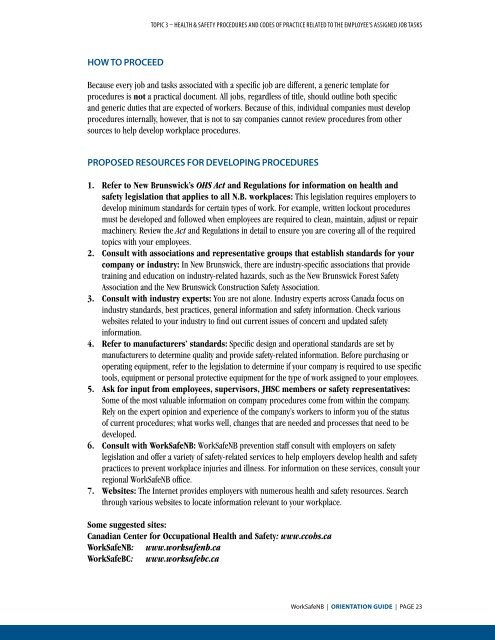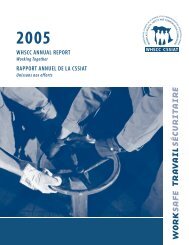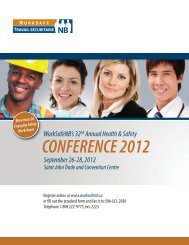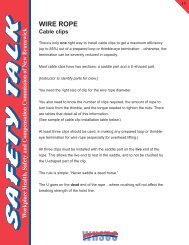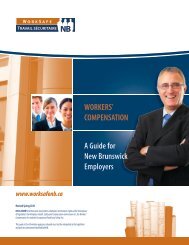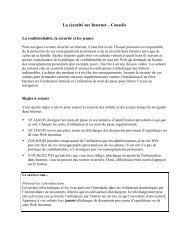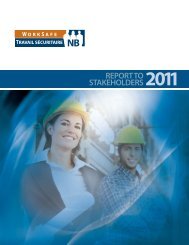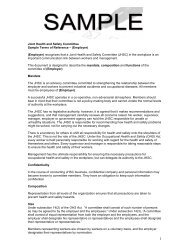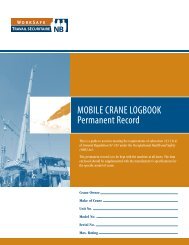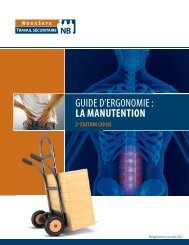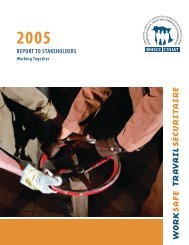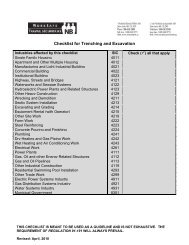HEALTH & SAFETY ORIENTATION GUIDE for ... - WorkSafeNB
HEALTH & SAFETY ORIENTATION GUIDE for ... - WorkSafeNB
HEALTH & SAFETY ORIENTATION GUIDE for ... - WorkSafeNB
- No tags were found...
Create successful ePaper yourself
Turn your PDF publications into a flip-book with our unique Google optimized e-Paper software.
Topic 3 – Health & Safety Procedures and Codes of Practice related to the employee’s assigned job tasksHow to proceedBecause every job and tasks associated with a specific job are different, a generic template <strong>for</strong>procedures is not a practical document. All jobs, regardless of title, should outline both specificand generic duties that are expected of workers. Because of this, individual companies must developprocedures internally, however, that is not to say companies cannot review procedures from othersources to help develop workplace procedures.Proposed Resources <strong>for</strong> Developing Procedures1. Refer to New Brunswick’s OHS Act and Regulations <strong>for</strong> in<strong>for</strong>mation on health andsafety legislation that applies to all N.B. workplaces: This legislation requires employers todevelop minimum standards <strong>for</strong> certain types of work. For example, written lockout proceduresmust be developed and followed when employees are required to clean, maintain, adjust or repairmachinery. Review the Act and Regulations in detail to ensure you are covering all of the requiredtopics with your employees.2. Consult with associations and representative groups that establish standards <strong>for</strong> yourcompany or industry: In New Brunswick, there are industry-specific associations that providetraining and education on industry-related hazards, such as the New Brunswick Forest SafetyAssociation and the New Brunswick Construction Safety Association.3. Consult with industry experts: You are not alone. Industry experts across Canada focus onindustry standards, best practices, general in<strong>for</strong>mation and safety in<strong>for</strong>mation. Check variouswebsites related to your industry to find out current issues of concern and updated safetyin<strong>for</strong>mation.4. Refer to manufacturers’ standards: Specific design and operational standards are set bymanufacturers to determine quality and provide safety-related in<strong>for</strong>mation. Be<strong>for</strong>e purchasing oroperating equipment, refer to the legislation to determine if your company is required to use specifictools, equipment or personal protective equipment <strong>for</strong> the type of work assigned to your employees.5. Ask <strong>for</strong> input from employees, supervisors, JHSC members or safety representatives:Some of the most valuable in<strong>for</strong>mation on company procedures come from within the company.Rely on the expert opinion and experience of the company’s workers to in<strong>for</strong>m you of the statusof current procedures; what works well, changes that are needed and processes that need to bedeveloped.6. Consult with <strong>WorkSafeNB</strong>: <strong>WorkSafeNB</strong> prevention staff consult with employers on safetylegislation and offer a variety of safety-related services to help employers develop health and safetypractices to prevent workplace injuries and illness. For in<strong>for</strong>mation on these services, consult yourregional <strong>WorkSafeNB</strong> office.7. Websites: The Internet provides employers with numerous health and safety resources. Searchthrough various websites to locate in<strong>for</strong>mation relevant to your workplace.Some suggested sites:Canadian Center <strong>for</strong> Occupational Health and Safety: www.ccohs.ca<strong>WorkSafeNB</strong>: www.worksafenb.caWorkSafeBC: www.worksafebc.ca<strong>WorkSafeNB</strong> | Orientation Guide | Page 23


